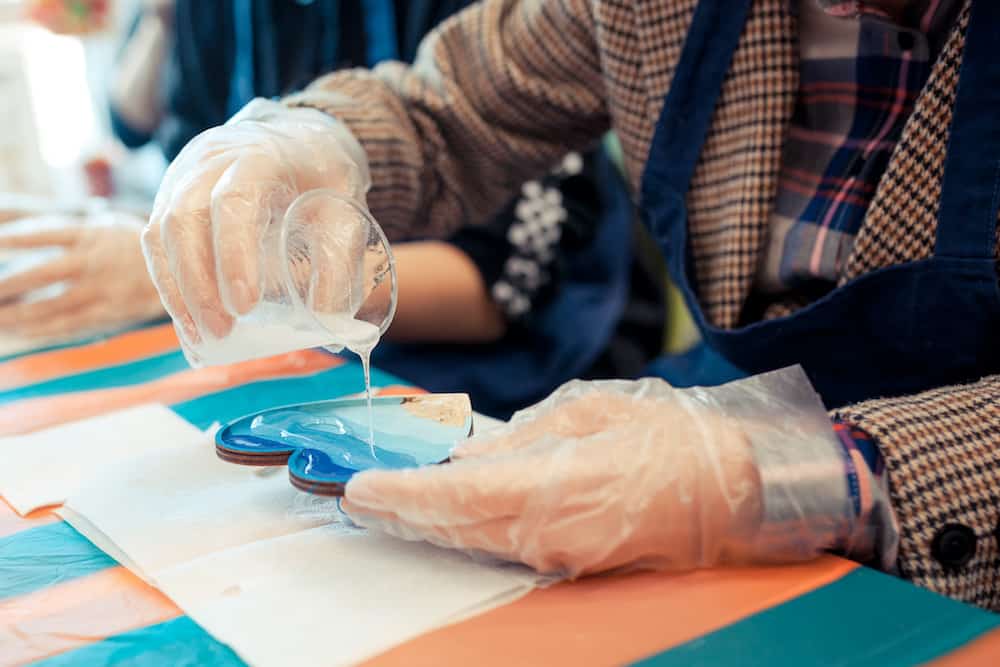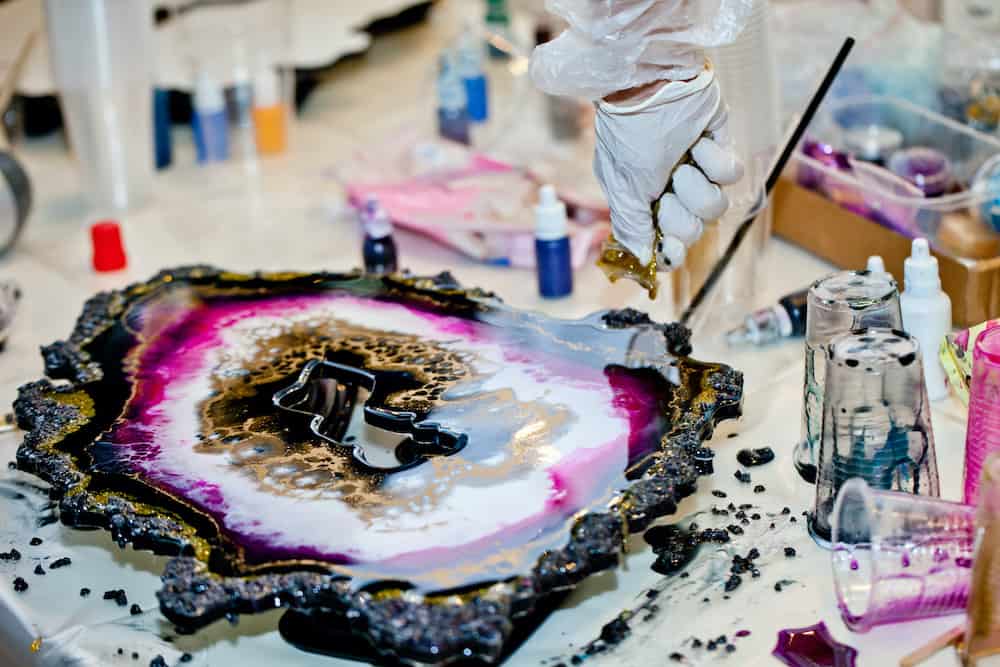The meaning of resin art is multifaceted and multilayered. After all, it comes in various forms that require different types of resin.
Thus, before answering the question, “What is resin art?“, you need to understand what resin is.
We’ll teach you what resin and resin art is, plus how to make a resin art.
What Is Resin?
Resin is a high-gloss, high-viscosity substance derived from both organic and synthetic sources.
With it having a somewhat similar characteristic to plastic, there are many opinions about these two materials.
Most people consider it a type of plastic, while others look at it the other way around with plastic simply being the result of processed resin.
One the other hand, there are individuals who believe that plastic and resin are completely the same.
That said, the material we’ll refer to is different from the traditional plastic used in plastic bags, toys, or outdoor furniture.
Types of Resin Used in Art
There are several types of resins and plastics, but there are only three commonly used in art, and they are:
1. Acrylic
Aptly named, this resin is the material used for clear acrylic products, such as lenses, screens, and containers.
It is made by mixing a powder, acrylic polymer, and a liquid called methyl methacrylate monomer, which serves as a hardener.
The result is a thermoplastic product that you can reheat and manipulate even after setting.
Keep in mind that acrylic resin components are highly toxic and flammable.
It has powders that can cause instant blindness if they get in your eyes accidentally.
Thus, this is more usable in an industrial setting rather than a creative one.
2. Polymer
Polymer and epoxy resins are classified as thermosetting plastics, which means heat doesn’t melt them the way thermoplastics do.
On the contrary, heat, or another type of catalyst, can solidify them, resulting in a solid finished product that can’t be remelted.
You can think of polymer as similar or an affordable alternative to epoxy resin, but only of lesser quality.
As such, we only use it for casting into molds and not for projects that require a more delicate look.
Feel free to experiment with it, though, especially since it’s cheaper than its epoxy counterpart.
That said, polymer resin also has harmful components. Specifically, you shouldn’t use it in a confined environment because of its fumes and strong odor.
3. Epoxy
Epoxy resin is our favorite go-to material for making art since you can use it for different types of resin art.
Plus, out of the three resins, epoxy is the safest material to work with, evidenced in the absence of the foul smell and multiple health warning labels.
Still, you should take precautions when using it since it can cause a nasty allergic reaction to one’s skin.
What Is Resin Art?
Simply put, it is a work of art created with resin materials, particularly polymer or epoxy resin.
Preparing both polymer and epoxy resin requires mixing two components: the main resin ingredient and its liquid catalyst or hardener.
That is why these products usually come in pairs.
Various brands require different resin to hardener ratios, so make sure to read their packaging before mixing them.
What you’ll end up with is a medium that is ready to be used for your artworks in three different ways:
1. Casting
Casting is the process where you pour the resin mix into a mold.
There are various objects and molds you can use for resin casting. You can even make your own.
Just don’t use thin plastic ones, such as those used to make candy, since the resin will strongly adhere to it.
We recommend looking into silicone baking molds because they’re cheap and come in a plethora of designs.
Check the inner finishing of your chosen mold, as well. It can either be glossy or frosty, consequently dictating the exterior texture of your finished piece.
2. Pouring
Another popular method in making resin art is pouring, such as the one we are dedicated to.
It’s a process where the resin is poured onto a surface to create a marbled 2D piece, as opposed to casting that creates 3D ones.
The beauty of pouring is the translucent and ethereal layering of colors that can be difficult to recreate using other mediums.
3. Coating
Coating is a method that combines casting and pouring techniques wherein you will coat an object with resin either for sealing or aesthetic purposes.
You’ll find that there are actually many objects that you can coat with resin, both organic like flower and wood, and inorganic like toys and memorabilia.
How to Make Resin Art
Resin art is a lot of fun, so we definitely recommend giving each method a try or even a combination of them to find your “inner resin art voice”.
The Basic Steps to Follow
Making resin art, though, regardless of how much you can play and experiment with it, begins with a series of fundamental steps.
1. Wear Protective Gear
Never forget to wear gloves before touching any resin product. A face mask is also recommended, especially when working with polymer.
2. Prepare Your Resin Mixture
Mix your resin and hardener according to the ratio stated in the packaging using two separate measuring cups and a wooden popsicle stick to stir.
Pro Tip:
It is best to use polypropylene measuring cups. You’ll find a lot of manufacturers that sell disposable measuring cups specifically intended for resin art.
However, we prefer using polypropylene ones, even their disposable variants, because of their reusability.
To remove set or hardened resin, simply roll the cup in your hand. You’ll hear a satisfying crunch—the sound of the resin separating from the cup.
You can simply peel it off with your fingers. It’s even easier if you have left your wooden stirrer in since you can use it to pull the resin out.
You can further remove smaller bits using clear tape. Polypropylene and resin don’t mix, making it very easy to separate the two, even with minimum effort.
3. Add Color Into Your Resin Mixture
Aside from the liquid pigments and tints specifically formulated for resin art, here are three other colorants that you can use:
- Liquid Acrylic: Use this sparingly and make sure to mix it well. Too much and its thickness can make your resin mixture clumpy.
- Fluid Acrylic: Compared to liquid acrylics, this medium is thinner and more fluid in viscosity, making it better for resin art. It’s more pigmented, though, so be careful in your application.
- Airbrush Paints: The viscosity of this medium is closely similar to fluid acrylics and actual resin liquid colorants, making them a popular choice for both beginners and more experienced resin artists alike.
Pro Tip:
Our go-to formula when coloring resin mixtures is a 1:10 ratio of tint and resin parts, respectively.
You can always deviate from it, depending on your intended opacity and vibrancy. Just add a few drops of tint at a time and mix well before adding more.
Remember, it’s always easy to add more tint, but diluting your mix because you’ve added too much pigment is such an absolute pain that it will be easier to start again.
Besides colorants, you can also add glitters, beads, and other materials that you think will make your resin mix more appropriate for the look that you’re going for.
4. Enjoy Creating Your Art
You’ll probably need several cups of resin mixtures depending on the number of colors you want to use.
Once you’re done concocting them, you can move ahead to the best part: making your resin art!
Pour your resin onto the mold or surface that you want to work with; do this slowly to minimize bubble formation.
The charm of resin art is the marbling effect of the interaction of resin mixtures while they are still wet.
Still, you can wait for a few hours for the resin to set in between pouring if you want to create multiple layers.
5. Pop Bubbles
Regardless of how many layers you want to achieve, you would want to tap down your mold or surface slightly to allow the bubbles to surface and the resin to level.
It is preferable to use a torch or a heat gun to pop bubbles, but not required. You can also use a toothpick to pick and pop them off carefully.
6. Let It Set
Finally, allow your work to rest for at least 24 hours, and you’re done!
Getting Into Resin Art
So, what is resin art? It is a kind of art that uses the medium known as resin.
There are different resin types, but polymer and epoxy resins are the two most frequently used by artists in casting, pouring, or coating methods.
Regardless of the resin you choose to work with, though, they all have toxic substances that can harm one’s health.
Thus, make sure to wear the proper protective gear, especially a mask and pair of gloves, when using it in your art.
To start making resin art, mix the resin and catalyst according to the specified ratio, add your colorants, and experiment.
Have fun!





thanks for this essay cuz i was planning to start to make resin art and this helped me out
I’ve read various articles about keeping your artwork covered to avoid particles from landing on it, is this absolutely necessary? Does dust show up on resin? I think it would be hard to keep certain pieces covered for any length of time.
hello good morning please I want to learn resin art and I want to know how I
should gets the materials for practice purposes